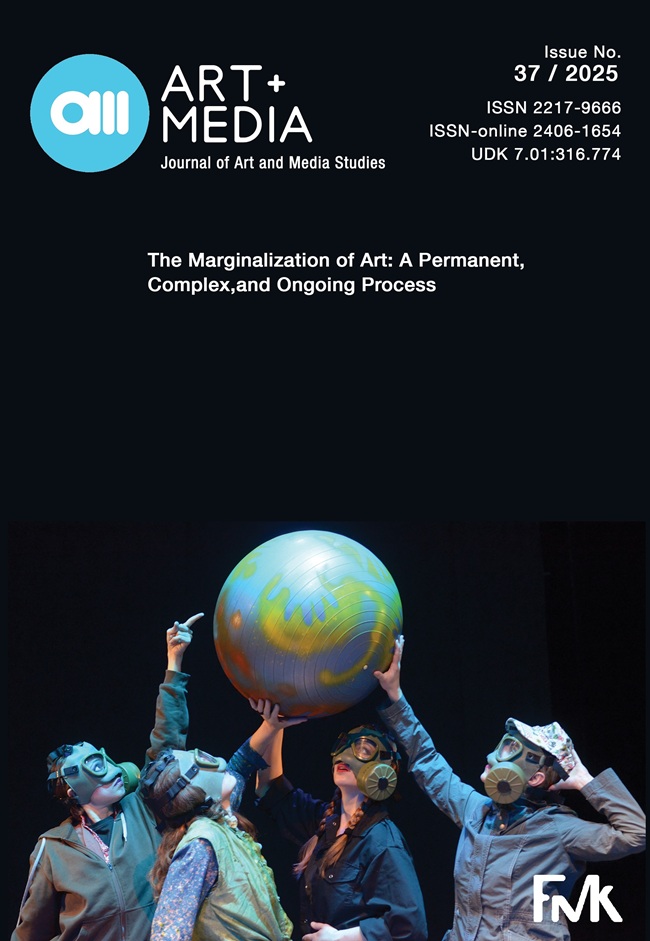Engaged Art Practice and Institutional Change: A Brief Introduction to Art Experiments in Yugoslavia and Serbia from 1968 to the Present
DOI:
https://doi.org/10.25038/am.v0i28.623Keywords:
participation; engagement; art labor; avant-garde; democratization; art institution; social change; Student Cultural Centre.Abstract
This article will explore examples of art practices and the work of curators in Yugoslavia and Serbia, from 1968 until the present, and will attempt to challenge the capitalist logic of the dominant art institution and its criteria that enable the exploitation of the work of artists. Focusing on collaboration, participation, democratization, and transformative experiences, these practices are shifting the modes of production and disturbing hierarchies between the artist, the artists’ work, and the audience. This shift implies changes in the nature of artwork, trying to re-imagine and test a new institutional framework outside the dominant art system and its logic of exploitation. The examples explored emerged from the student and youth centres in Yugoslavia around 1968, from the anti-war movement of the 1990s in Serbia, and from the so-called independent cultural scene in Serbia during the first decades of the 21stcentury. This paper’s focus is inspired by the current students’ protests taking place in Serbia and the need to analyze them in relation to the legacies of the art practices which can be recognized in some features of the current movement and its related artistic articulations.
References
Bago, Ivana. “Dematerijalizacija i politizacija izložbe: Primjeri kustoske prakse kao antikapitalističke institucionalne kritike u Jugoslaviji tijekom 60ih i 70ih godina 20. stoljeća.” Radovi Instituta za povijest umjetnosti 36 (2012): 235–48. https://www.ipu.hr/content/radovi-ipu/RIPU-36-2012_235-248_Bago.pdf.
Benjamin, Walter. “The Author as Producer.” In Walter Benjamin Selected Writings, Volume 2, Part 2, edited by Michael W. Jennings, Howard Eiland, and Gary Smith, 768-782. The Belknap Press of Harvard University Press, 2005.
Bishop, Claire. Artificial Hells – Participatory Art and Politics of Spectatorship. Verso, 2012.
Bogdanović, Slavko. POLITIKA TELA: Izabrani radovi 1967–1997. Književni novosadski krug K21K, Prometej, 1997.
Bürger, Peter. Theory of the Avant-Garde. Translated by Michael Shaw. Manchester University Press, 1984.
Čukić, Iva and Pekić, Milica. “Magacin as a Common Good.” In Magacin: A Model for Self-organized Cultural Centre, edited by Iva Čukić, Ana Dimitrijević, Lana Gunjić, Luka Knežević-Strika, Jelena Mijić, Milica Pekić, Aleksandar Popović, Sanja Radulović, 6–17. Association Independent Cultural Scene of Serbia, 2019.
Dedić, Nikola. “Avant-Garde Transformation of Artistic Labor: The Productivist View of Boris Arvatov”, Art and Media Journal 28 (2022): 133–51. https://doi.org/10.25038/am.v0i28.523. DOI: https://doi.org/10.25038/am.v0i28.523
Денегри, Јеша. “Језик уметности и систем уметности.” Октобар 75, Студентски културни центар, 1975.
Kojić Mladenov, Sanja. Bogdanka Poznanović. Contact Art. Muzej savremene umetnosti Vojvodine, 2016.
Koščević, Želimir. “Akcija Total – nacrt dekreta o demokratizaciji umetnosti.”Almanah 4. Bitef, 1970.
Ладик, Каталин. “Пројекат за акцију – ИКС ЧЕНЏ АРТ – уметност, размене, измене и промене.”7. Билтен, 5. априлски сусрет, Студентски културни центар, 1976.
Matičević, Davor.“Zagrebački krug.” In Nova umjetnička praksa 1966–1978, edited by Marijan Susovski, 21-28. Galerija suvremene umjetnosti, 1978.
Popović Miroslav, Nune. “Falus revolucija za novo društvo.” Nune Popović i grupa Magnet, Živela sloboda, Muzej savremene umetnosti Vojvodine, 2011.
Praznik, Katja. Art Work: Invisible Labour and the Legacy of Yugoslav Socialism. University of Toronto Press, 2021. DOI: https://doi.org/10.3138/9781487538187
Radosavljević, Darka, ed. Zbogom andergraund Saša Marković Mikrob. Remont, 2013.
Savanović, Saša. “The protests in Serbia are historic, the world shouldn’t ignore them.” Aljazeera, February 23, 2025. https://www.aljazeera.com/opinions/2025/2/23/the-protests-in-serbia-are-historic-the-world-shouldnt-ignore-them.
Šuvaković, Miško. Csernik Attila. Muzej savremene umetnosti Vojvodine, Vujičić kolekcija, 2009.
Томић, Биљана. “Сусрети средом.” In Дрангуларијум (exhibition catalogue). Студентски културни центар, 1971.
Vesić, Jelen. “SKC (Student Cultural Centre) as a Site of Performative (Self-)Production: October 75 – Institution, Self-organization, First-person Speech, Collectivization.” Život umjetnosti 91(2012): 30–53. https://www.ipu.hr/content/zivot-umjetnosti/ZU_91-2012_030-053_Vesic.pdf.
Yildiz Seda, ed. Building Human Relations Through Art: Škart Collective (Belgrade), from 1990 to Present. Onomatopee, 2022.
Downloads
Published
How to Cite
Issue
Section
License
Copyright (c) 2025 AM Journal of Art and Media Studies

This work is licensed under a Creative Commons Attribution-NonCommercial-NoDerivatives 4.0 International License.
The content on this site is licensed under a Creative Commons Attribution 4.0 International License.
AM Journal of Art and Media Studies ISSN 2217-9666 - printed, ISSN 2406-1654 - online, UDK 7.01:316.774
Contact: amjournal@outlook.com
Publisher: Faculty of Media and Communications, Singidunum University, Belgrade, Serbia
Indexed in: ERIH PLUS, EBSCO, DOAJ, and in The List of Scientific Journals Categorization of Ministry of Education, Science and Technological Development of Republic of Serbia (M24 in 2021; M23 in 2023). Beginning with No. 12 2017, AM is indexed, abstracted and covered in Clarivate Analytics service ESCI.

